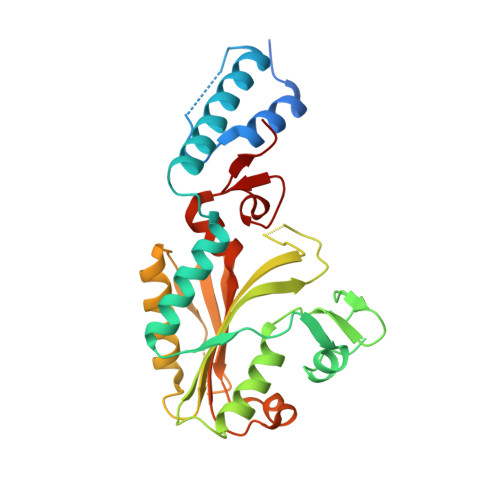Multistep Engineering of Pyrrolysyl-tRNA Synthetase to Genetically Encode N(varepsilon)-(o-Azidobenzyloxycarbonyl) lysine for Site-Specific Protein Modification
Yanagisawa, T., Ishii, R., Fukunaga, R., Kobayashi, T., Sakamoto, K., Yokoyama, S.(2008) Chem Biol 15: 1187-1197
- PubMed: 19022179
- DOI: https://doi.org/10.1016/j.chembiol.2008.10.004
- Primary Citation of Related Structures:
2ZIN, 2ZIO - PubMed Abstract:
Pyrrolysyl-tRNA synthetase (PylRS) esterifies pyrrolysine to tRNA(Pyl). In this study, N(epsilon)-(tert-butyloxycarbonyl)-L-lysine (BocLys) and N(epsilon)-allyloxycarbonyl-L-lysine (AlocLys) were esterified to tRNA(Pyl) by PylRS. Crystal structures of a PylRS catalytic fragment complexed with BocLys and an ATP analog and with AlocLys-AMP revealed that PylRS requires an N(epsilon)-carbonyl group bearing a substituent with a certain size. A PylRS(Y384F) mutant obtained by random screening exhibited higher in vitro aminoacylation and in vivo amber suppression activities with BocLys, AlocLys, and pyrrolysine than those of the wild-type PylRS. Furthermore, the structure-based Y306A mutation of PylRS drastically increased the in vitro aminoacylation activity for N(epsilon)-benzyloxycarbonyl-L-lysine (ZLys). A PylRS with both the Y306A and Y384F mutations enabled the large-scale preparation (>10 mg per liter medium) of proteins site-specifically containing N(epsilon)-(o-azidobenzyloxycarbonyl)-L-lysine (AzZLys). The AzZLys-containing protein was labeled with a fluorescent probe, by Staudinger ligation.
Organizational Affiliation:
Systems and Structural Biology Center, Yokohama Institute, RIKEN, 1-7-22 Suehiro-cho, Tsurumi, Yokohama 230-0045, Japan.
















